Plumbing
Plumbing is any system that conveys fluids for a wide range of applications. Heating and cooling, waste removal, and potable water delivery are among the most common uses for plumbing; however, plumbing is not limited to these applications.[1] Plumbing utilizes pipes, valves, plumbing fixtures, tanks, and other apparatuses to convey fluids.[2] Trades that work with plumbing such as boilermakers, plumbers, and pipefitters are referred to the plumbing trade. In the developed world plumbing infrastructure is critical for public health and sanitation.[3][4]
The word derives from the Latin plumbum for lead, as the first effective pipes used in Roman era were lead pipes.[5]
History
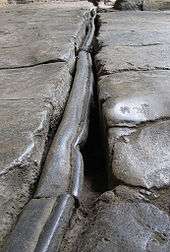
Plumbing originated during ancient civilizations such as the Greek, Roman, Persian, Indian, and Chinese cities as they developed public baths and needed to provide potable water and wastewater removal, for larger numbers of people.[6] Standardized earthen plumbing pipes with broad flanges making use of asphalt for preventing leakages appeared in the urban settlements of the Indus Valley Civilization by 2700 B.C.[7] The Romans used lead pipe inscriptions to prevent water theft.
Plumbing reached its early apex in ancient Rome, which saw the introduction of expansive systems of aqueducts, tile wastewater removal, and widespread use of lead pipes. With the Fall of Rome both water supply and sanitation stagnated—or regressed—for well over 1,000 years. Improvement was very slow, with little effective progress made until the growth of modern densely populated cities in the 1800s. During this period, public health authorities began pressing for better waste disposal systems to be installed, to prevent or control epidemics of disease. Earlier, the waste disposal system had merely consisted of collecting waste and dumping it on the ground or into a river. Eventually the development of separate, underground water and sewage systems eliminated open sewage ditches and cesspools.
Most large cities today pipe solid wastes to sewage treatment plants in order to separate and partially purify the water, before emptying into streams or other bodies of water. For potable water use, galvanized iron piping was commonplace in the United States from the late 1800s until around 1960. After that period, copper piping took over, first soft copper with flared fittings, then with rigid copper tubing utilizing soldered fittings.
The use of lead for potable water declined sharply after World War II because of increased awareness of the dangers of lead poisoning. At this time, copper piping was introduced as a better and safer alternative to lead pipes.[8][9]
Systems

The major categories of plumbing systems or subsystems are:[10]
- potable cold and hot tap water supply
- plumbing drainage venting
- sewage systems and septic systems with or without hot water heat recycling and graywater recovery and treatment systems
- Rainwater, surface, and subsurface water drainage
- fuel gas piping
- hydronics, i.e. heating and cooling systems utilizing water to transport thermal energy, as in district heating systems, like for example the New York City steam system.
Water pipes
A water pipe is a pipe or tube, frequently made of plastic or metal,[lower-alpha 1] that carries pressurized and treated fresh water to a building (as part of a municipal water system), as well as inside the building.
History

For many centuries, lead was the favoured material for water pipes, because its malleability made it practical to work into the desired shape. (Such use was so common that the word "plumbing" derives from plumbum, the Latin word for lead.) This was a source of lead-related health problems in the years before the health hazards of ingesting lead were fully understood; among these were stillbirths and high rates of infant mortality. Lead water pipes were still widely used in the early 20th century, and remain in many households. In addition, lead-tin alloy solder was commonly used to join copper pipes, but modern practice uses tin-antimony alloy solder instead, in order to eliminate lead hazards.[11]
Despite the Romans' common use of lead pipes, their aqueducts rarely poisoned people. Unlike other parts of the world where lead pipes cause poisoning, the Roman water had so much calcium in it that a layer of plaque prevented the water contacting the lead itself. What often causes confusion is the large amount of evidence of widespread lead poisoning, particularly amongst those who would have had easy access to piped water.[12] This was an unfortunate result of lead being used in cookware and as an additive to processed food and drink, for example as a preservative in wine.[13] Roman lead pipe inscriptions provided information on the owner to prevent water theft.
Wooden pipes were used in London and elsewhere during the 16th and 17th centuries. The pipes were hollowed-out logs, which were tapered at the end with a small hole in which the water would pass through.[14] The multiple pipes were then sealed together with hot animal fat. They were often used in Montreal and Boston in the 1800s, and built-up wooden tubes were widely used in the USA during the 20th century. These pipes, used in place of corrugated iron or reinforced concrete pipes, were made of sections cut from short lengths of wood. Locking of adjacent rings with hardwood dowel pins produced a flexible structure. About 100,000 feet of these wooden pipes were installed during WW2 in drainage culverts, storm sewers and conduits, under highways and at army camps, naval stations, airfields and ordnance plants.
Cast iron and ductile iron pipe was long a lower-cost alternative to copper, before the advent of durable plastic materials but special non-conductive fittings must be used where transitions are to be made to other metallic pipes, except for terminal fittings, in order to avoid corrosion owing to electrochemical reactions between dissimilar metals (see galvanic cell).[15]
Bronze fittings and short pipe segments are commonly used in combination with various materials.[16]
Difference between pipes and tubes
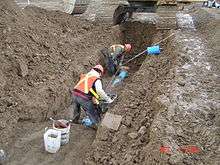
The difference between pipes and tubes is simply in the way it is sized. PVC pipe for plumbing applications and galvanized steel pipe for instance, are measured in IPS (iron pipe size). Copper tube, CPVC, PeX and other tubing is measured nominally, which is basically an average diameter. These sizing schemes allow for universal adaptation of transitional fittings. For instance, 1/2" PeX tubing is the same size as 1/2" copper tubing. 1/2" PVC on the other hand is not the same size as 1/2" tubing, and therefore requires either a threaded male or female adapter to connect them. When used in agricultural irrigation, the singular form "pipe" is often used as a plural.[17]
Pipe is available in rigid "joints", which come in various lengths depending on the material. Tubing, in particular copper, comes in rigid hard tempered "joints" or soft tempered (annealed) rolls. PeX and CPVC tubing also comes in rigid "joints" or flexible rolls. The temper of the copper, that is whether it is a rigid "joint" or flexible roll, does not affect the sizing.[17]
The thicknesses of the water pipe and tube walls can vary. Pipe wall thickness is denoted by various schedules or for large bore polyethylene pipe in the UK by the Standard Dimension Ratio (SDR), defined as the ratio of the pipe diameter to its wall thickness. Pipe wall thickness increases with schedule, and is available in schedules 20, 40, 80, and higher in special cases. The schedule is largely determined by the operating pressure of the system, with higher pressures commanding greater thickness. Copper tubing is available in four wall thicknesses: type DWV (thinnest wall; only allowed as drain pipe per UPC), type 'M' (thin; typically only allowed as drain pipe by IPC code), type 'L' (thicker, standard duty for water lines and water service), and type 'K' (thickest, typically used underground between the main and the meter). Because piping and tubing are commodities, having a greater wall thickness implies higher initial cost. Thicker walled pipe generally implies greater durability and higher pressure tolerances.
Wall thickness does not affect pipe or tubing size.[18] 1/2" L copper has the same outer diameter as 1/2" K or M copper. The same applies to pipe schedules. As a result, a slight increase in pressure losses is realized due to a decrease in flowpath as wall thickness is increased. In other words, 1 foot of 1/2" L copper has slightly less volume than 1 foot of 1/2 M copper.
Materials
Water systems of ancient times relied on gravity for the supply of water, using pipes or channels usually made of clay, lead, bamboo, wood, or stone. Hollowed wooden logs wrapped in steel banding were used for plumbing pipes, particularly water mains. Logs were used for water distribution in England close to 500 years ago. US cities began using hollowed logs in the late 1700s through the 1800s.[8] Today, most plumbing supply pipe is made out of steel, copper, and plastic; most waste (also known as "soil")[19] out of steel, copper, plastic, and cast iron.[19]
The straight sections of plumbing systems are called "pipes" or "tubes". A pipe is typically formed via casting or welding, whereas a tube is made through extrusion. Pipe normally has thicker walls and may be threaded or welded, while tubing is thinner-walled and requires special joining techniques such as brazing, compression fitting, crimping, or for plastics, solvent welding. These joining techniques are discussed in more detail in the piping and plumbing fittings article.
Steel
Galvanized steel potable water supply and distribution pipes are commonly found with nominal pipe sizes from 3⁄8 inch (9.5 mm) to 2 inches (51 mm). It is rarely used today for new construction residential plumbing. Steel pipe has National Pipe Thread (NPT) standard tapered male threads, which connect with female tapered threads on elbows, tees, couplers, valves, and other fittings. Galvanized steel (often known simply as "galv" or "iron" in the plumbing trade) is relatively expensive, and difficult to work with due to weight and requirement of a pipe threader. It remains in common use for repair of existing "galv" systems and to satisfy building code non-combustibility requirements typically found in hotels, apartment buildings and other commercial applications. It is also extremely durable and resistant to mechanical abuse. Black lacquered steel pipe is the most widely used pipe material for fire sprinklers and natural gas.
Most typical single family home systems won't require supply piping larger than 3⁄4 inch (19 mm) due to expense as well as steel piping's tendency to become obstructed from internal rusting and mineral deposits forming on the inside of the pipe over time once the internal galvanizing zinc coating has degraded. In potable water distribution service, galvanized steel pipe has a service life of about 30 to 50 years, although it is not uncommon for it to be less in geographic areas with corrosive water contaminants.
Copper
Copper pipe and tubing was widely used for domestic water systems in the latter half of the twentieth century. Demand for copper products has fallen due to the dramatic increase in the price of copper, resulting in increased demand for alternative products including PEX and stainless steel.
Plastic

Plastic pipe is in wide use for domestic water supply and drain-waste-vent (DWV) pipe. Principal types include: Polyvinyl chloride (PVC) was produced experimentally in the 19th century but did not become practical to manufacture until 1926, when Waldo Semon of BF Goodrich Co. developed a method to plasticize PVC, making it easier to process. PVC pipe began to be manufactured in the 1940s and was in wide use for Drain-Waste-Vent piping during the reconstruction of Germany and Japan following WWII. In the 1950s, plastics manufacturers in Western Europe and Japan began producing acrylonitrile butadiene styrene (ABS) pipe. The method for producing cross-linked polyethylene (PEX) was also developed in the 1950s. Plastic supply pipes have become increasingly common, with a variety of materials and fittings employed.
- PVC/CPVC – rigid plastic pipes similar to PVC drain pipes but with thicker walls to deal with municipal water pressure, introduced around 1970. PVC stands for polyvinyl chloride, and it’s become a common replacement for metal piping. PVC should be used only for cold water, or for venting. CPVC can be used for hot and cold potable water supply. Connections are made with primers and solvent cements as required by code.[20]
- PP – The material is used primarily in housewares, food packaging, and clinical equipment,[21] but since the early 1970s has seen increasing use worldwide for both domestic hot and cold water. PP pipes are heat fused, being unsuitable for the use of glues, solvents, or mechanical fittings. PP pipe is often used in green building projects.[22][23]
- PBT – flexible (usually gray or black) plastic pipe which is attached to barbed fittings and secured in place with a copper crimp ring. The primary manufacturer of PBT tubing and fittings was driven into bankruptcy by a class-action lawsuit over failures of this system. However, PB and PBT tubing has since returned to the market and codes, typically first for "exposed locations" such as risers.
- PEX – cross-linked polyethylene system with mechanically joined fittings employing barbs, and crimped steel or copper rings.
- Polytanks – plastic polyethylene cisterns, underground water tanks, above ground water tanks, are usually made of linear polyethylene suitable as a potable water storage tank, provided in white, black or green.
- Aqua – known as PEX-Al-PEX, for its PEX/aluminum sandwich, consisting of aluminum pipe sandwiched between layers of PEX, and connected with modified brass compression fittings. In 2005, a large number of these fittings were recalled.
Present-day water-supply systems use a network of high-pressure pumps, and pipes in buildings are now made of copper,[24] brass, plastic (particularly cross-linked polyethylene called PEX, which is estimated to be used in 60% of single-family homes[25]), or other nontoxic material. Due to its toxicity, lead has not been used in modern water-supply piping since the 1930s in the United States,[26] although lead was used in plumbing solder for drinking water until it was banned in 1986.[26] Drain and vent lines are made of plastic, steel, cast-iron, or lead.[27][28]
Gallery
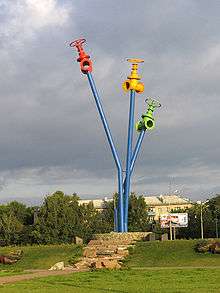 Monument to water pipe in Mytishchi (Russia)
Monument to water pipe in Mytishchi (Russia) A specific water pipe made for use with pressure vessels. The pipe can sustain high pressure-water and is relatively small
A specific water pipe made for use with pressure vessels. The pipe can sustain high pressure-water and is relatively small Concrete water pipe
Concrete water pipe Connecting to an existing water line (white pipe) with a stainless steel tapping sleeve and valve (red). A concrete thrust block is being formed behind the new connection.
Connecting to an existing water line (white pipe) with a stainless steel tapping sleeve and valve (red). A concrete thrust block is being formed behind the new connection.
Components
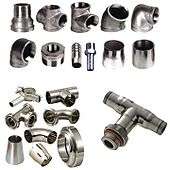
In addition to lengths of pipe or tubing, pipe fittings are used in plumbing systems, such as valves, elbows, tees, and unions.[29] Pipe and fittings are held in place with pipe hangers and strapping.
Plumbing fixtures are exchangeable devices using water that can be connected to a building's plumbing system. They are considered to be "fixtures", in that they are semi-permanent parts of buildings, not usually owned or maintained separately. Plumbing fixtures are seen by and designed for the end-users. Some examples of fixtures include water closets[30] (also known as toilets), urinals, bidets, showers, bathtubs, utility and kitchen sinks, drinking fountains, ice makers, humidifiers, air washers, fountains, and eye wash stations.
Sealants
Threaded pipe joints are sealed with thread seal tape or pipe dope. Many plumbing fixtures are sealed to their mounting surfaces with plumber's putty.[31]
Equipment and tools
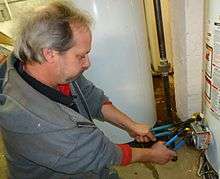
Plumbing equipment includes devices often hidden behind walls or in utility spaces which are not seen by the general public. It includes water meters, pumps, expansion tanks, back flow preventers, water filters, UV sterilization lights, water softeners, water heaters, heat exchangers, gauges, and control systems.
There are many tools [32] a plumber needs to do a good plumbing job. While many simple plumbing tasks can be completed with a few common hand held tools, other more complex jobs require specialised tools, designed specifically to make the job easier.
Specialized plumbing tools include pipe wrenches, flaring pliers, pipe vise, pipe bending machine, pipe cutter, dies and joining tools such as soldering torches and crimp tools. New tools have been developed to help plumbers fix problems more efficiently. For example, plumbers use video cameras for inspections of hidden leaks or problems, they use hydro jets, and high pressure hydraulic pumps connected to steel cables for trench-less sewer line replacement.
Flooding from excessive rain or clogged sewers may require specialized equipment, such as a heavy duty pumper truck designed to vacuum raw sewage.
Problems
Bacteria have been shown to live in "premises plumbing systems". The latter refers to the "pipes and fixtures within a building that transport water to taps after it is delivered by the utility".[33] Community water systems have been known for centuries to spread waterborne diseases like typhoid and cholera, however "opportunistic premises plumbing pathogens" have been recognized only more recently; Legionella pneumophila discovered in 1976, Mycobacterium avium, and Pseudomonas aeruginosa are the most commonly tracked bacteria, which people with depressed immunity can inhale or ingest and may become infected with.[34] These opportunistic pathogens can grow for example in faucets, shower heads, water heaters and along pipe walls. Reasons that favor their growth are "high surface-to-volume ratio, intermittent stagnation, low disinfectant residual, and warming cycles". A high surface-to-volume ratio, i.e. a relatively large surface area allows the bacteria to form a biofilm, which protects them from disinfection.[34]
Regulation

Much of the plumbing work in populated areas is regulated by government or quasi-government agencies due to the direct impact on the public's health, safety, and welfare. Plumbing installation and repair work on residences and other buildings generally must be done according to plumbing and building codes to protect the inhabitants of the buildings and to ensure safe, quality construction to future buyers. If permits are required for work, plumbing contractors typically secure them from the authorities on behalf of home or building owners.
In the United Kingdom the professional body is the Chartered Institute of Plumbing and Heating Engineering (educational charity status) and it is true that the trade still remains virtually ungoverned;[35] there are no systems in place to monitor or control the activities of unqualified plumbers or those home owners who choose to undertake installation and maintenance works themselves, despite the health and safety issues which arise from such works when they are undertaken incorrectly; see Health Aspects of Plumbing (HAP) published jointly by the World Health Organization (WHO) and the World Plumbing Council (WPC).[36][37] WPC has subsequently appointed a representative to the World Health Organization to take forward various projects related to Health Aspects of Plumbing.[38]
In the United States, plumbing codes and licensing are generally controlled by state and local governments. At the national level, the Environmental Protection Agency has set guidelines about what constitutes lead-free plumbing fittings and pipes, in order to comply with the Safe Drinking Water Act.
Some widely used Standards in the United States are:
- ASME A112.6.3 – Floor and Trench Drains
- ASME A112.6.4 – Roof, Deck, and Balcony Drains
- ASME A112.18.1/CSA B125.1 – Plumbing Supply Fittings
- ASME A112.19.1/CSA B45.2 – Enameled Cast Iron and Enameled Steel Plumbing Fixtures
- ASME A112.19.2/CSA B45.1 – Ceramic Plumbing Fixtures
See also
- Active fire protection
- Copper pipe
- Domestic water system
- Double-walled pipe
- EPA Lead and Copper Rule
- Fire hose
- Flange
- Garden hose
- Heat pipe
- Hose
- Passive fire protection
- Pipe
- Pipe fitting
- Pipe network analysis
- Pipeline transport
- Piping and plumbing fittings
- Plastic pipework
- Plastic pressure pipe systems
- Plumbing & Drainage Institute
- Plumbosolvency
- Sanitation in ancient Rome
- Tube
- Victaulic
- Water supply network
References
- ↑ Blankenbaker, Keith. Modern Plumbing. Goodheart Willcox.
- ↑ Muscroft, Steve (2016-03-14). Plumbing. Elsevier. p. 3.
- ↑ "Health Aspects of Plumbing".
- ↑ Plumbing: the Arteries of Civilization, Modern Marvels video series, The History Channel, AAE-42223, A&E Television, 1996
- ↑ "What Is The Origin Of The Word "plumbing"?". Pittsburgh Post-Gazette. May 12, 1942. Retrieved December 27, 2013.
- ↑ "Archaeologists Urge Pentagon To Keep Soldiers From Destroying". Herald-Journal. Mar 19, 2003. Retrieved December 27, 2013.
- ↑ Teresi et al. 2002
- 1 2 Kavanaugh, Sean. "History of Plumbing Pipe and Plumbing Material". Archived from the original on May 24, 2013.
- ↑ "Public Notice .Lead Contamination Informative City Ok Moscow Water System". Moscow-Pullman Daily News. August 12, 1988. Retrieved December 27, 2013.
- ↑ "Basic Plumbing System". Retrieved 4 January 2016.
- ↑ "Lead in Drinking Water". Epa.gov. Retrieved 22 January 2014.
- ↑ Hansen, Roger. "WATER AND WASTEWATER SYSTEMS IN IMPERIAL ROME". Waterhistory.org. Retrieved 22 January 2014.
- ↑ Lead Poisoning: http://penelope.uchicago.edu/~grout/encyclopaedia_romana/wine/leadpoisoning.html
- ↑ "Wooden water pipe". BBC. Retrieved 22 January 2014.
- ↑ "Types of Pipe Material". Virginia's Community Colleges. Retrieved 22 January 2014.
- ↑ Worldwide Market for Industrial and Domestic Water Equipment as of 2010. PwC. March 2012. Retrieved January 28, 2014.
- 1 2 "Difference between Pipes and Tubes". Retrieved 22 January 2014.
- ↑ "Wall thickness does not affect pipe o" (PDF). Retrieved 22 January 2014.
- 1 2 http://www.cispi.org/products/types.aspx Cast Iron Soil Pipe Institute
- ↑ "What's the difference between PVC and CPVC pipe?".
- ↑ Bidisha Mukherjee. "Polypropylene Properties and Uses". Buzzle.
- ↑ http://www.greenbuildingpro.com/resources/whitepapers/1337-one-of-utahs-leeding-residences-full
- ↑ "Walking The Talk". pmengineer.com.
- ↑ Copper Tube Handbook, the Copper Development Association, New York, USA, 2006
- ↑ California’s PEX Battle Continues. Builderonline.com
- 1 2 Macek, MD.; Matte, TD.; Sinks, T.; Malvitz, DM. (Jan 2006). "Blood lead concentrations in children and method of water fluoridation in the United States, 1988–1994.". Environ Health Perspect. 114 (1): 130–4. doi:10.1289/ehp.8319. PMC 1332668
 . PMID 16393670.
. PMID 16393670. - ↑ Uniform Plumbing Code, IAPMO
- ↑ International Plumbing Code, ICC
- ↑ "Miscellaneous Valves". Retrieved December 27, 2013.
- ↑ "Basic Plumbing Principles". The Evening Independent. November 10, 1926. Retrieved December 27, 2013.
- ↑ "Key To Pop-up Drain Is Fresh Plumber's Putty". Daily News. January 12, 2003. Retrieved December 27, 2013.
- ↑ Plumbing Tool Kit
- ↑ Carol Potera (August 2015). "Plumbing Pathogens: A Fixture in Hospitals and Homes". Environ Health Perspecives;. 123 (8). doi:10.1289/ehp.123-A217.
- 1 2 Joseph O. Falkinham III, Elizabeth D. Hilborn, Matthew J. Arduino, Amy Pruden, and Marc A. Edwards (August 2015). "Epidemiology and Ecology of Opportunistic Premises Plumbing Pathogens: Legionella pneumophila, Mycobacterium avium, and Pseudomonas aeruginosa". Environ Health Perspecives;. 123 (8). doi:10.1289/ehp.1408692.
- ↑ "The Chartered Institute of Plumbing and Heating Engineering (CIPHE)". Retrieved March 29, 2014.
- ↑ "World Plumbing Council". Retrieved October 11, 2009.
- ↑ "WHO Health aspects of plumbing". Retrieved October 11, 2009.
- ↑ "World Plumbing Council". Retrieved October 11, 2009.
Notes
- ↑ Materials used to make water pipes are polyvinyl chloride, polypropylene, polyethylene, ductile iron, cast iron, steel, copper and formerly lead.
Further reading
- Teresi, Dick (2002). Lost Discoveries: The Ancient Roots of Modern Science--from the Babylonians to the Maya. New York: Simon & Schuster. pp. 351–352. ISBN 0-684-83718-8.
External links
-
 Media related to Plumbing at Wikimedia Commons
Media related to Plumbing at Wikimedia Commons -
 The dictionary definition of plumbing at Wiktionary
The dictionary definition of plumbing at Wiktionary -
 Quotations related to Plumbing at Wikiquote
Quotations related to Plumbing at Wikiquote -
 Plumbing at Wikibooks
Plumbing at Wikibooks - ATSDR Case Studies in Environmental Medicine: Lead Toxicity U.S. Department of Health and Human Services
- Lead Water Pipes and Infant Mortality in Turn-of-the-Century Massachusetts
- Case Studies in Environmental Medicine - Lead Toxicity
- ToxFAQs: Lead

